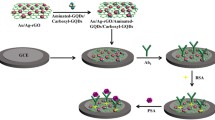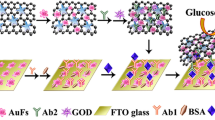Abstract
High molecular-weight silk peptide (SP) was used to functionalize the surface of nanosheets of reduced graphene oxide (rGO). The SP-rGO nanocomposite was then mixed with mouse anti-human prostate specific antigen monoclonal antibody (anti-PSA) and coated onto a glassy carbon electrode to fabricate an immunosensor. By using the hexacyanoferrate redox system as electroactive probe, the immunosensor was characterized by voltammetry and electrochemical impedance spectroscopy. The peak current, measured at the potential of 0.24 V (vs. SCE), is distinctly reduced after binding prostate specific antigen (PSA). Response (measured by differential pulse voltammetry) is linearly related to PSA concentration in the range from 0.1 to 5.0 ng · mL−1 and from 5.0 to 80.0 ng∙mL−1, and the detection limit is 53 pg∙mL−1 (at an SNR of 3). The immunosensor was successfully applied to the determination of PSA in clinical serum samples, and the results were found to agree well with those obtained with an enzyme-linked immunosorbent assay.

Nanosheets of reduced graphene oxide were functionalized with silk peptide and used to immobilize anti-PSA to fabricate an immunosensor for PSA.




Similar content being viewed by others
References
Stamey TA, Yang N, Hay AR, McNeal JE, Freiha FS, Redwine E (1987) Prostate-specific antigen as a serum marker for adenocarcinoma of the prostate. New Engl J Med 317:909
Catalona WJ, Richie JP, Ahmann FR, Hudson MA, Scardino PT, Flanigan RC, deKemion JB, Ratliff TL, Kavoussi LR, Dalkin BL (1994) Comparison of digital rectal examination and serum prostate specific antigen in the early detection of prostate cancer: results of a multicenter clinical trial of 6,630 men. J Urol 151:1283
Gann PH, Hennekens CH, Stampfer MJ (1995) A prospective evaluation of plasma prostate specific antigen for detection of prostatic cancer. J Am Med Assoc 273:289
Meany DL, Zhang Z, Sokoll LJ, Zhang H, Chan DW (2009) Glycoproteomics for prostate cancer detection: changes in serum PSA glycosylation patterns. J Proteome Res 8:613
Lang QL, Wang F, Yin L, Liu MJ, Petrenko VA, Liu AH (2014) Specific probe selection from landscape phage display library and its application in enzyme-linked immunosorbent assay of free prostate-specific antigen. Anal Chem 86:2767
Graves HC, Wehner N, Stamey TA (1992) Ultrasensitive radioimmunoassay of prostate-specific antigen. Clinic Chem 38:735
Oh SW, Kim YM, Kim HJ, Kim SJ, Cho JS, Choi E (2009) Point-of-care fluorescence immunoassay for prostate specific antigen. Clin Chim Acta 406:18
Hutchinson RW, Ma RL, McLeod CW, Milford-Ward A, Lee D (2004) Immunoassay with FI-ICP-MS detection-Measurement of free and total prostate specific antigen in human serum. Can J Anal Sci Spectrosc 49:429
Barbero G, Destefanis P, Procida S, Mandili G, Ulliers D, Ceruti C, Fiori C, Maule MM, Fontana D, Giribaldi G (2008) Highly specific detection of prostate-specific antigen-positive cells in the blood of patients with prostate cancer or benign prostatic hyperplasia, using a real-time reverse-transcription-polymerase chain reaction method with improved sensitivity. BJU Int 102:1566
Wan Y, Deng WP, Su Y, Zhu XH, Peng C, Hu HY, Peng HZ, Song SP, Fan CH (2011) Carbon nanotube-based ultrasensitive multiplexing electrochemical immunosensor for cancer biomarkers. Biosens Bioelectron 30:3093
Ghindilis A, Atanasov P, Wilkins M, Wilkins E (1998) Immunosenors: electrochemical sensing and other engineering approaches. Biosens Bioelectron 13:113
Warsinke A, Benkert A, Scheller FW (2000) Electrochemical immunoassays. Fresenius J Anal Chem 366:622
Pandey B, Demchenko AV, Stine KJ (2012) Nanoporous gold as a solid support for protein immobilization and development of an electrochemical immunoassay for prostate specific antigen and carcinoembryonic antigen. Microchim Acta 179:71
Salimi A, Kavosi B, Fathi F, Hallaj R (2013) Highly sensitive immunosensing of prostate-specific antigen based on ionic liquid–carbon nanotubes modified electrode: Application as cancer biomarker for prostatebiopsies. Biosens Bioelectron 42:439
Tian JN, Huang JL, Zhao YC, Zhao SL (2012) Electrochemical immunosensor for prostate-specific antigen using a glassy carbon electrodemodified with a nanocomposite containing gold nanoparticles supported with starch-functionalized multi-walled carbon nanotubes. Microchim Acta 178:81
Poon CY, Chan HM, Li HW (2014) Direct detection of prostate specific antigen by darkfield microscopy using single immunotargeting silver nanoparticle. Sensors Actuators B Chem 190:737
Peng J, Zhu YD, Li XH, Jiang LP, Abdel-Halim ES, Zhu JJ (2014) Electrochemical immunoassay for the prostate specific antigen using ceria mesoporous nanospheres. Microchim Acta 181:1505
Liu B, Lu LS, Hua EH, Jiang ST, Xie GM (2012) Detection of the human prostate-specific antigen using an aptasensor with gold nanoparticles encapsulated by graphitized mesoporous carbon. Microchim Acta 178:163
Wu D, Li R, Wang HX, Liu SQ, Wang H, Wei Q, Du B (2012) Hollow mesoporous silica microspheres as sensitive labels for immunoassay of prostate-specific antigen. Analyst 137:608
Wang H, Zhang Y, Yu HQ, Wu D, Ma HM, Li H, Du B, Wei Q (2013) Label-free electrochemical immunosensor for prostate-specific antigenbased on silver hybridized mesoporous silica nanoparticles. Anal Biochem 434:123
Kumar V, Srivastava S, Umrao S, Kumar R, Nath G, Sumana G, Saxena PS, Srivastava A (2014) Nanostructured palladium-reduced graphene oxide platform for high sensitive, label free detection of a cancer biomarker. RSC Advances 4:2267
Geim AK, Novoselov AK (2007) The rise of graphene. Nat Mater 6:183
Novoselov KS, Geim AK, Morozov S, Jiang D, Zhang Y, Dubonos SV, Grigorieva V, Firsov AA (2004) Electric field effect in atomically thin carbon films. Science 306:666
Novoselov KS, Jiang Z, Zhang Y, Morozov SV, Stormer HL, Zeitler U, Maan JC, Boebinger GS, Kim P, Geim AK (2007) Room-temperature quantum hall effect in graphene. Science 315:1379
Wei W, Qu X (2012) Extraordinary physical properties of functionalized graphene. Small 8:2138
Laaksonen P, Kainlauri M, Laaksonen T, Shchepetov A, Jiang H, Ahopelto J, Linder MB (2010) Interfacial engineering by proteins: exfoliation and functionalization of graphene by hydrophobins. Angew Chem Int Edit 49:4946
Shan C, Yang H, Han D, Zhang Q, Ivaska A, Niu L (2009) Water-soluble graphene covalently functionalized by biocompatible poly-l-lysine. Langmuir 25:12030
Qu Y, Ma M, Wang ZG, Zhan GQ, Li BH, Wang X, Fang HF, Zhang HJ, Li CY (2013) Sensitive amperometric biosensor for phenolic compounds based on graphene–silk peptide/tyrosinase composite nanointerface. Biosens Bioelectron 44:85
Kovtyukhova NI, Ollivier PJ, Martin BR, Mallouk TE, Chizhik SA, Buzaneva EV, Gorchinskiy AD (1999) Layer-by-Layer assembly of ultrathin composite films from micron-sized graphite oxide sheets and polycations. Chem Mater 11:771
Hummers W, Offeman R (1958) Preparation of Graphitic Oxide. J Am Chem Soc 80:1339
Du M, Yang T, Ma SY, Zhao CZ, Jiao K (2011) Ionic liquid-functionalized graphene as modifier for electrochemical and electrocatalytic improvement: comparison of different carbon electrodes. Anal Chim Acta 690:169
Acknowledgments
The authors gratefully acknowledge the financial supports from National Natural Science Foundation of China (No. 21275166), China Scholarship Council (No. 201307780006), and Research Foundation of General Administration of Quality Supervision, Inspection and Quarantine of the People’s Republic of China (No. 2013Qk286).
Author information
Authors and Affiliations
Corresponding authors
Electronic supplementary material
Below is the link to the electronic supplementary material.
ESM 1
(DOC 9219 kb)
Rights and permissions
About this article
Cite this article
Wang, Y., Qu, Y., Liu, G. et al. Electrochemical immunoassay for the prostate specific antigen using a reduced graphene oxide functionalized with a high molecular-weight silk peptide. Microchim Acta 182, 2061–2067 (2015). https://doi.org/10.1007/s00604-015-1552-2
Received:
Accepted:
Published:
Issue Date:
DOI: https://doi.org/10.1007/s00604-015-1552-2




